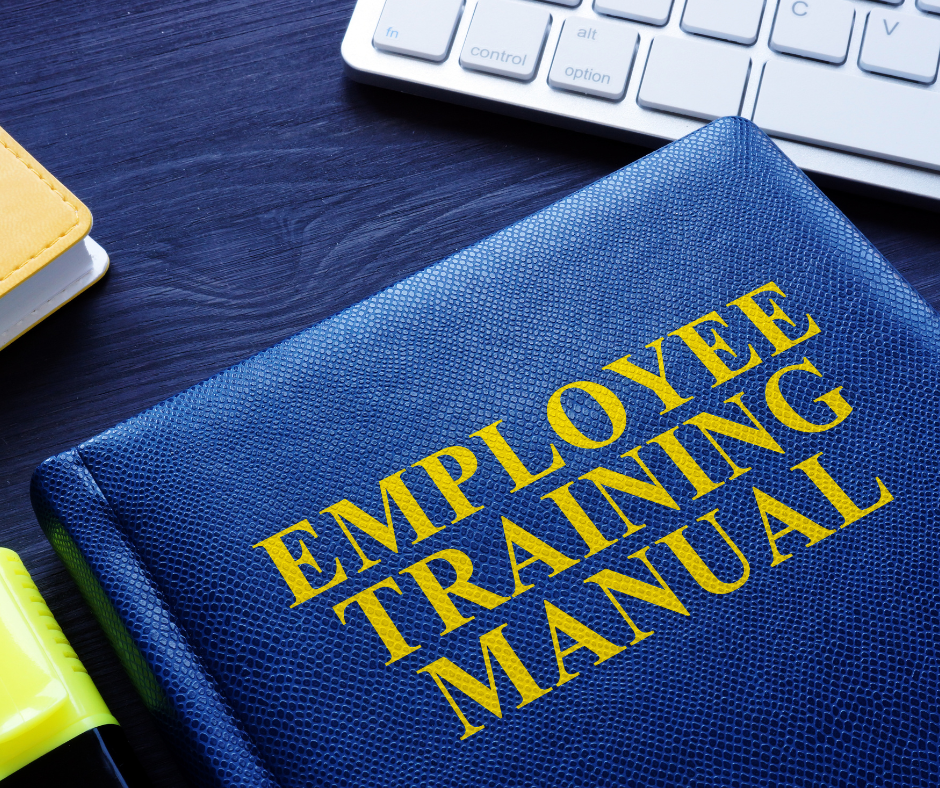
Crafting professional templates for training manuals can be a game-changer for organizations seeking to streamline employee onboarding and skill development while bolstering operational efficiency. With the right approach and tools, you can create manuals that engage employees, maximize learning, and drive success.
Key Takeaways
- Training manuals are essential resources for businesses to efficiently onboard, develop skills, and optimize operational efficiency.
- Effective training manual templates should include clear objectives and goals, engaging content & visuals, and a structured layout & organization.
- Utilizing digital tools like online document editors or learning management systems can help create tailored professional templates that maximize employee knowledge retention.
The Value of Training Manuals
Training manuals have become essential for businesses in today’s fast-paced work environment. These indispensable tools help facilitate efficient onboarding, foster skill improvement, and promote operational effectiveness. An employee training manual can be advantageous for training employees, employers, and clients by furnishing thoroughly researched procedures and encouraging uniformity across the organization.
The benefits of utilizing training manual templates include:
- Standardizing processes
- Optimizing workflows
- Reducing errors
- Facilitating documentation and tracking of training initiatives
Creating engaging and effective training manuals involves using straightforward language, integrating practical examples, and fostering active learning. The key elements of professional training manual templates and useful tips for crafting a comprehensive guide will be the focus of the forthcoming sections, aiming to cater to your organization’s unique needs.

Streamlining Onboarding
A well-designed training manual plays a crucial role in streamlining the onboarding process, ensuring new employees quickly adapt to their roles and responsibilities. By incorporating engaging content, such as quizzes, exercises, and case studies, training manuals can be made interactive, actively involving learners in the training process and enhancing knowledge retention.
Customizing training manuals for specific roles enables organizations to:
- Provide relevant information and resources tailored to the job duties and responsibilities of each employee
- Increase employee productivity
- Aid in the seamless integration of new hires into the organization.
Gathering feedback during the onboarding process is valuable, as it allows for timely modifications to the training, thereby enhancing its effectiveness and productivity.
Enhancing Skill Development
The enhancement of skill development relies on providing comprehensive training materials that cater to various learning styles and preferences. Visuals, such as diagrams, charts, and infographics, can help learners comprehend complex concepts more easily and retain information more effectively.
Incorporating real-world examples within training manuals can further improve the learning experience by demonstrating the practical application of the skills being taught. By addressing the unique requirements of each role and tailoring the training manual to the specific industry standards or company requirements, organizations can ensure that employees acquire the knowledge and skills necessary for success in their roles.
Supporting Operational Efficiency
Training manuals contribute to operational efficiency by providing a standardized approach to processes and procedures, thereby reducing errors and ensuring consistency throughout the organization. Proper employee training can help keep employees productive, foster innovation, and is key to sustaining successful organizational performance.
An agile, data-driven approach to training program management enables objectivity to be maintained and keeps the program relevant and profitable. Monitoring and adjusting training programs ensures they are meeting the desired outcomes and contributing to overall operational efficiency.
Manual of Operations Template
A manual of operations template serves as a structured guide that outlines procedures, protocols, and instructions essential for the efficient functioning of an organization or a specific project. This meticulously designed document encapsulates a comprehensive framework that facilitates uniformity and standardization across various operational aspects. The manual of operations template typically includes vital information such as roles and responsibilities, workflow processes, safety measures, troubleshooting guidelines, and communication protocols. By utilizing this template, an organization can ensure that all members are on the same page regarding how to conduct their duties and handle different scenarios. It not only enhances operational efficiency but also contributes to a cohesive and well-organized work environment, ultimately leading to improved productivity and quality of outcomes.
Key Components of Effective Training Manual Templates

Creating an effective training manual requires a focus on three key components: clear objectives and goals, engaging content and visuals, and a structured layout and organization. By establishing well-defined objectives, captivating content, and an orderly layout, training manual templates can help ensure that employees have access to the necessary information and resources to excel in their roles.
The forthcoming sections will detail each of these components, offering insights and tips that aid in crafting a professional training manual template aligned with your organization’s unique needs.
Clear Objectives and Goals
Establishing clear objectives and goals for a training program is necessary to ensure that employees comprehend the purpose and anticipated results of the training. The introduction section of a training manual should be:
- Succinct
- Alluring
- Comprehensible
- Articulating the primary purpose of the specific training program.
By outlining the goals and targets of the training program, objectives provide guidance to new employees as they progress through the program. This enables employees to understand the desired outcomes of the training, giving them a clear sense of direction and a better understanding of their roles and responsibilities.
Engaging Content and Visuals
Incorporating engaging content and visuals into training manuals is essential for creating effective learning materials. Some examples of visuals that can enhance the learning experience of employees, aid in information retention, and increase employee productivity during the training process include:
- Charts
- Diagrams
- Pictures
- Infographics
- High-quality images
By including these visuals in your training manuals, you can create more engaging and effective learning materials.
The use of interactive elements, such as quizzes, exercises, and case studies, can actively engage learners and make the learning experience more enjoyable. By capturing the attention of learners and facilitating better understanding and retention of information, engaging content and visuals contribute significantly to the overall effectiveness of a training manual.
Structured Layout and Organization
A structured layout and organization are crucial in ensuring that employees can easily find the necessary information in a training manual. Elements such as headings, subheadings, and sections guide users through the manual and make it easier to navigate. Additionally, incorporating grids and diagrams can further improve readability and scannability, allowing users to quickly find the relevant content.
By providing a clear organizational hierarchy, a structured layout can significantly enhance user navigation in training manuals, ensuring that employees have access to the information they need when they need it. This not only contributes to a more effective learning experience but also helps employees stay focused and engaged throughout the training process.
Customizing Training Manual Templates for Different Roles

Tailoring training manual templates to specific roles is essential to ensure that the individual requirements of each role are adequately met. By taking into account role-specific requirements, industry standards, and company policies and culture, organizations can create training manuals that are relevant, comprehensive, and effective in delivering the necessary information to their employees.
In the following sections, we will discuss:
- How to identify role-specific requirements
- How to adapt templates for industry standards
- How to incorporate company policies and culture when customizing training manual templates for different roles.
Identifying Role-Specific Requirements
The requirements for each role vary depending on the job duties and responsibilities associated with it. To ensure that the training manual effectively addresses the needs of each role, it is important to consider the specific skills and knowledge required for different job responsibilities. For instance, a data scientist might need to possess proficiency in data analysis and machine learning, while a digital marketer may need to have knowledge of branding strategy and content creation.
By identifying the unique requirements of each role and tailoring the training manual to address these needs effectively, organizations can ensure that both the employee and the organization benefit. This not only increases employee productivity but also aids in the seamless integration of new hires into the organization.
Adapting Templates for Industry Standards
Adapting templates to meet industry standards and best practices is crucial in ensuring employees receive up-to-date and relevant training. Industry standards offer guidance and recommended practices that should be taken into account when customizing training manual templates. Abiding by these standards helps sustain uniformity, enhance training efficacy, and guarantee adherence to regulations and quality standards.
To stay informed of industry standard updates, businesses can:
- Subscribe to industry-specific newsletters
- Join industry associations
- Regularly review regulatory body websites
- Attend industry conferences
- Interact with industry peers.
By keeping abreast of the latest industry standards and incorporating them into training manual templates, organizations can ensure that their training materials remain relevant, comprehensive, and effective in delivering the necessary information to their employees.
Incorporating Company Policies and Culture
Incorporating company policies and culture into training manuals is essential for promoting a consistent and unified approach to work across the organization. This can be accomplished by including relevant company policies, procedures, and guidelines, as well as providing examples of how to apply them in different scenarios.
Additionally, incorporating activities and exercises in a training manual is an effective way to reinforce company policies and culture. Examples of these activities include role-playing, quizzes, and simulations. By integrating company policies and culture within the training manual, organizations can ensure that employees have a clear understanding of the expectations and values that guide their work.
Types of HR Policies and Procedures
When delving into the realm of human resources, understanding the various types of HR policies and procedures is paramount. HR policies are guidelines that outline the organization’s expectations and standards of conduct, covering aspects such as recruitment, compensation, benefits, and employee behavior. On the other hand, procedures are the step-by-step instructions on how to implement these policies in day-to-day operations. The categories of HR policies encompass recruitment and selection policies, performance management policies, leave and attendance policies, employee conduct policies, and compensation and benefits policies. Each of these categories is tailored to address specific aspects of workforce management, ensuring a structured and consistent approach within the organization.
Tips for Creating Engaging and Effective Training Manuals

Creating engaging and effective training manuals requires a combination of clear objectives, captivating content, and a well-organized layout. In addition, using plain language, incorporating real-world examples, and encouraging active learning can further enhance the overall effectiveness of a training manual.
Each of these tips will be explored in detail in the upcoming sections, offering insights and practical advice to assist in crafting a professional training manual template fitting your organization’s unique needs.
Using Plain Language
Ensuring the content is easily understood by employees necessitates writing in plain language and avoiding jargon and technical terms when possible. For clear and concise communication, using plain language in designing effective training manuals is imperative. This includes utilizing simple and straightforward language, breaking down complex information into manageable sections, and providing step-by-step instructions. Doing so enhances readability, facilitates knowledge retention, and decreases the need for additional explanations or mistakes.
By writing in plain language, training manuals can effectively communicate complex concepts and procedures to employees, ensuring they have a clear understanding of their roles and responsibilities. This not only improves employee productivity but also contributes to a more effective and efficient training process.
Incorporating Real-World Examples
Including real-world examples and case studies in training manuals can help employees better understand and apply the concepts and skills being taught. Real-world examples demonstrate the practical application of training concepts in actual work situations, making the training more engaging and practical for learners.
Incorporating real-world examples also promotes higher-order thinking skills, such as analysis, synthesis, and evaluation, which are crucial for success in the workplace. By providing relevant, practical examples and scenarios, organizations can ensure that their training materials are not only engaging but also effective in preparing employees for the challenges they will face on the job.
Encouraging Active Learning
Active learning has been scientifically proven to result in significantly increased message retention compared to passive learning methods. Encouraging active learning through interactive activities, quizzes, and discussions can promote better engagement and knowledge retention among employees.
By involving learners in the learning process and encouraging them to engage with the material, reflect on it, and draw connections to their prior knowledge, active learning facilitates a deeper understanding, critical thinking, and improved retention of the material. Furthermore, active learning encourages collaboration, creativity, and the development of higher-order skills among learners.
Utilizing Digital Tools for Training Manual Creation

Digital tools can significantly streamline the process of creating engaging and effective training manuals. Online document editors, design and visualization tools, and learning management systems all offer valuable features that can enhance the overall quality and effectiveness of your training materials, making them training manuals interactive.
The subsequent sections will detail each of these digital tools, offering insights and advice on their effective utilization in creating professional training manual templates that align with your organization’s unique needs.
Online Document Editors
Online document editors, such as Google Docs or Microsoft Word, allow users to:
- Create, edit, and collaborate on documents in real-time
- Streamline the creation process and ensure consistency across materials
- Access various features and functionalities that can enhance the quality of training manuals, such as templates, collaboration, formatting and styling options, version control, and integration with multimedia.
By leveraging the capabilities of online document editors, organizations can create training manuals that are not only visually appealing and engaging but also consistent and up-to-date with the latest industry standards and best practices.
Design and Visualization Tools
Design and visualization tools, such as Visme or Canva, can help create visually appealing and engaging training materials, enhancing the overall learning experience for employees. These tools offer a wide range of features, such as:
- Templates
- Graphics
- Color schemes
- Multimedia integration
These features allow users to customize their training materials and organize training sessions to meet the unique needs of their organization.
By using design and visualization tools, organizations can create training manuals that are not only visually captivating but also effective in facilitating better understanding and retention of information.
Learning Management Systems

Learning Management Systems (LMS) are software platforms utilized to organize, track, and manage training programs, ensuring employees have access to the requisite resources and support. LMS platforms serve as a data repository where learners can access all the necessary learning materials, allowing them to complete training at their own pace.
Implementing an LMS can streamline the organization, tracking, and management of employee training programs, ensuring that employees receive the necessary information and resources to excel in their roles. This not only increases employee productivity but also aids in the seamless integration of new hires into the organization.
Summary
Crafting professional templates for training manuals is essential for organizations seeking to streamline employee onboarding, skill development, and operational efficiency. By focusing on clear objectives, engaging content, and a structured layout, and leveraging digital tools such as online document editors, design and visualization tools, and learning management systems, you can create training manuals that truly engage employees, maximize learning, and drive success.
Frequently Asked Questions
How do I create a training manual template?
To create a training manual template, start by defining the audience, planning the content, determining the content presentation format, developing the content, assembling and delivering the manual, and tracking feedback to keep the content updated.
What is the best software to create a training manual?
The best software to create a training manual is EdApp, Tovuti LMS, Coassemble, ProProfs, Scribe, Trainual, TechSmith Snagit, Clickhelp, Bit.ai, Raptivity, and 360 Learning, all of which provide various features that cater to the needs of your training manual.
How to write a training manual PDF?
To write a training manual PDF, define your audience and objectives, create an outline for the material, provide section summaries, and use a professional tone to connect with readers. Additionally, gather feedback from users and make sure the final answer does not include any artifacts.
How do you structure a training manual?
To create a successful training manual, first define your audience and plan the content, then decide how to present it, develop the content and assemble the material. Finally, track feedback and keep the content updated.
How can I customize a training manual template for different roles within my organization?
Customize training manual templates for each role by identifying role-specific requirements, adapting templates for industry standards, and incorporating company policies and culture.